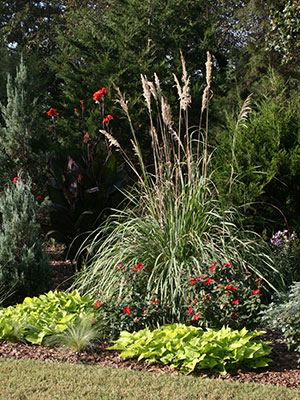 You don’t have to pamper pampas grass! This attractive perennial, which is native to Latin America – Brazil, Argentina, and Chile, is practically trouble-free. It’s well adapted to all areas of Florida. Pampas grass grows in large clumps, eight to ten feet high. In late summer, it produces showy silver –white or pinkish silken plumes, which may reach a height of 12 feet.
You don’t have to pamper pampas grass! This attractive perennial, which is native to Latin America – Brazil, Argentina, and Chile, is practically trouble-free. It’s well adapted to all areas of Florida. Pampas grass grows in large clumps, eight to ten feet high. In late summer, it produces showy silver –white or pinkish silken plumes, which may reach a height of 12 feet.
Pampas grass can be very eye-catching when used as a specimen plant in the landscape. Since it grows very rapidly into a massive plant, pampas grass can provide an excellent screen for sunny locations. Unfortunately, it is often used improperly as a foundation plant. In such cases, it usually is purchased from a nursery when it’s small and planted very near the home. At first, it will look fine, but, after several years, it will have reached such a large size that it will be difficult to find the house for the old pampas grass.
“This vigorous ornamental grass is widely used as a lawn specimen but its quick growth rate and large size make it unsuitable for all but large home landscapes. However, it is ideal for barrier or windbreak plantings and has a place in larger areas such as along highways or in commercial or industrial landscapes.” FPS145
There are many ornamental forms of pampas grass. The plum-like blooms differ between male and female plants. The female plumes are broad and full, due to the silky hairs covering the tiny flowers. The male plumes look narrow and short, because of the absence of hair on the flowers. Also, there is considerable variation among seedlings in growth habit, period of flowering, and size and shape of plumes. If uniformity is desired, pampas grass should be propagated by dividing clumps, rather than by seed.
The plumes of pampas grass are highly prized for indoor decorations. Plumes used for this purpose should be cut as soon as they have fully emerged. If mature plumes are brought indoors, they will fill the home with delicate fluffy flowers which can be a bigger problem than a shedding dog or cat. This shedding can be prevented by spraying mature plumes with hair spray.
When selecting planting site for pampas grass, special attention should be paid to the potential danger or injury to passersby from contact with the very sharp, saw-like edges of the leaves. Pampas grass should be planted where it will receive full sun for most of the day. In shady locations, it will grow very slowly and produce few, if any, plumes.
Pampas grass suffers from practically no pest or disease problems. It has good salt tolerance, and will grow in almost any soil. Once it’s established, about all you need to do is give it adequate fertilizer. For healthy growth and good plume production, pampas grass should be fertilized four times a year with a balanced fertilizer, such as an 8-8-8, applied at the rate of two pounds per 100 square feet.
In North Florida, pampas grass leaves are often killed by freezing temperatures. But, new leaves will sprout in the spring. Before spring growth begins, you should prune away brown leaves and other dead material that has accumulated at the base of your plants. When working around pampas grass, it’s a good ideas to wear long pants, a longs sleeve shirt, and gloves to protect you from the sharp leaf blades mentioned earlier.
The striking, feathery plumes and large, graceful clumps of foliage make pampas grass a very desirable addition to a landscape. Since it so trouble-free, perhaps you’d like to try some around your home.
- Muscadine Grape: a Popular Fruit for North Florida - August 10, 2015
- Southern Field Peas, a Summer Delight - July 14, 2015
- Caterpillars with a Sting - June 10, 2015
